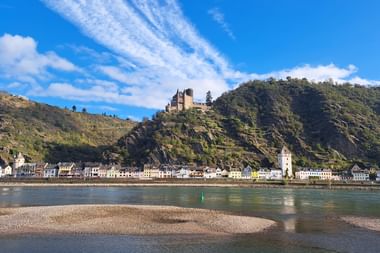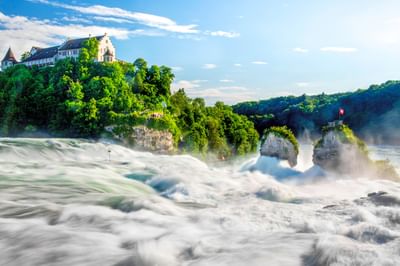The most beautiful cities on the romantic Rhine. . .
Mainz
The city of Mainz is famous for its old town, half-timbered houses and the medieval market. The bazaar fountain with red columns is located in the centre of the city. Not far away is the Romanesque Mainz Cathedral with its purple sandstone and striking octagonal towers. The Gutenberg Museum is particularly exciting. The museum is dedicated to the inventor of the printing press and presented two original editions of the Gutenberg Bible. Worth seeing is also the St. Stephan Church. The church is the only German church for which the Jewish artist Marc Chagall (1887 – 1985) created windows.
You can also enjoy the Rhine promenade in Mainz. The Adenauer shore stretches from the customs port to the old town and offers many varied scenery. Wide berths and numerous benches for sunbathing as well as the restored Rheintore Raimundi and Schlosstor invite you to a relaxing cycling break.

Rüdesheim
Rüdesheim am Rhein is a small town in the Rhine Valley in Germany, known for its wine production, especially for the Riesling. In the centre is the Drosselgasse with shops, bars and restaurants. Siegfried’s Mechanical Music Cabinet is also nearby. The Rheingau Wine Museum is located in the medieval castle of Brömserburg, where exhibits on wine production and wine enjoyment since ancient times are on display.

St. Goar
In the picturesque old town of St. Goar, numerous vineyards and the view of the Rhine Valley invite you to linger and enjoy. From the banks of the Rhine you can see the sister town of St. Goarshausen at the foot of Katz Castle. The city is centrally located between Koblenz and Rüdesheim, Boppard and Bacharach and is an ideal starting point for excursions to the romantic Loreley Valley, the Taunus and the Hunsrück. Sankt Goar is also known for its central location in the Upper and Middle Rhine Valley, which is a UNESCO World Heritage Site. The area was added to the World Heritage List in July 2002.

Bad Godesberg
The peaceful, rural area of Bad Godesberg is characterized by Godesburg, which was built in the 13th century. Some consulates recall Bonn as the federal capital. In the pedestrian zone there are many Asian, Oriental, Brazilian and Chinese restaurants to cater to the needs of more and more multicultural people. The castle-like Bismer Tower stands on the southern edge of the green hills of the region.
Attractions:
- Carillon
- House on the Redoute
- Elector’s line
- The Redoute
- Michael’s Chapel
Wesel
Attraction:
- Zitadelle Wesel
- Historische Rathausfassade
- Berliner Tor
- Schloss Diersfordt
- Denkmäler
- Willibrordi Dom
- Esel von Wesel
The city of Wesel is located in the middle of the idyllic cultural landscape of the Lower Rhine and combines urban and rural structures to create a special place and a special quality of life. Wesel offers a wide range of leisure and recreation opportunities: Whether the promenade or the boulevard, the small town on the Lower Rhine has a lot to offer. The modern and bright shopping street is over 700 metres long and up to 20 metres wide.
Emmerich
With the beginning of the New Rhine Promenade in 2003, the city underwent a major upheaval. The completion of the necessary flood protection works will be celebrated in 2007 with the grand opening ceremony Emmerich in the bright lights. Since then, the newly designed Rhine Promenade has attracted many tourists from the Lower Rhine and from all parts of the Netherlands. The city invites you to stroll and linger on the Rhine and on the longest suspension bridge in Germany.
Sights:
- Rheinmuseum
- PAN kunstform niederrhein
- Museum für Kaffeetechnik
- Sauna & Erlebnisbad EMBRICANA
Koblenz
Where father Rhine meets mother Mosel
Koblenz is a historic city in southwestern Germany and is considered a gateway to the Upper and Middle Rhine Valley due to its terraced vineyards and castle ruins. In the city centre, the Kaiser Wilhelm Monument marks the place where the Rhine and Moselle converge. A cable car goes directly to the Ehrenbreitstein Fortress on the hill, where there are several museums and cultural events. A little further south on the river bank is the neo-Gothic Stolzenfelsschloss and its gardens.

Discover many other sights in the city on the Rhine and Moselle.
In the Romanticum, which opened in 2013, visitors take a virtual boat across the multimedia Rhine through the UNESCO World Heritage Site “Oberrheintal”, unique in Germany. In ten independent exhibition areas with different designs, there are more than 70 interactive stations where passengers can experience the unique scenery of the UNESCO World Heritage Site and get to know the Rhine in all its aspects, attractions, legends and legends.In the Forum Confluentes, art, culture and education have found a new home in an ultra-modern, architecturally outstanding building. Six levels provide space for the art collection of the Middle Rhine Museum, the city library, the new interactive Romanticum, the tourist information centre and modern catering facilities.
The Elector’s Palace in Koblenz is one of the most important castles of early French Classicism in southwestern Germany and is one of the last residences to be built in Germany immediately before the French Revolution. Today, the castle offers unique spaces for festive banquets, gatherings and family celebrations. The exclusive Grand Café, with free access, invites you to visit.
The Deutschherren- or Deutschordenshaus in Koblenz was the first branch of the German Order in the Rhineland. Since 1992 the Ludwig Museum has been located here with contemporary, predominantly French art.
Also worth seeing are the 3. 5 km long Rhine facilities on the left side of the Rhine, which consist of the Konrad Adenauer-Ufer and the Kaiserin Augusta-Anlagen.
Duisburg
Ruhr area and Lower Rhine, industry and rural idyll, shopping malls and drinking halls, Philharmonic and harbours – Duisburg combines seemingly opposites into an exciting metropolitan mixture.
More and more visitors are exploring the city by bike. Duisburg has an excessive proportion of green and water areas. The Duisburg Zoo attracts visitors from far away all year round, and even the abandoned production facilities have been imaginatively transformed and are now part of the unique industrial culture.
Art museums and historical museums – Wilhelm Lehmbrücks and Gerhard Mercators – are major themes. In Duisburg you will find paintings and sculptures by world-renowned artists as well as exhibits on the history of the city and shipping. The landscape of the Duisburg Museum is highly esteemed.
Düsseldorf
Get on the pedals and discover the classic tourist attractions of Düsseldorf!
From the alleys of the old town to the world architecture of the MedienHafen to the real fairytale castle – Düsseldorf offers many special places. In the city on the Rhine, everything is close to one another: the Rhine Tower, Königsallee and Benrath Castle – each attraction tells its own story and is worth a visit.
Düsseldorf is hardly as green as other big cities. Parks and green areas form a green axis above the Rhine metropolis. The green oasis in the city center are the Rhine meadows, the Hofgarten and the Nordpark with its Japanese garden. The green lung of Düsseldorf is the Volksgarten, which is widely used in the Federal Garden Exhibition.
The Botanical Garden is an absolute insider tip.
Bad Hönningen
Bad Hönningen is a picturesque seaside town in the middle of the romantic Rhine. It is characterized by sun-drenched vineyards around Arenfels Castle, a mild climate and the Rhine Valley. In addition, the unique landscape and especially the recognized healing water. All this makes Bad Hönningen an ideal holiday destination!
You can walk along the Rhine and the picturesque wild romantic vineyards and cycle. A breathtaking and wonderful natural landscape awaits you at every corner. The ostrich taverns, the farmed huts and the restaurants provide for the physical well-being.
Discover the historical surroundings of the region, where the Romans feel at home. Countless palaces and castles, castle ruins, watchtowers and the Limes, a UNESCO World Heritage Site since 2005, are waiting to be discovered.
Lahnstein
In Lahnstein you can enjoy the impressive scenery along the shore. Enjoy the impressive scenery of the UNESCO World Heritage Upper Middle Rhine Valley and the idyllic nature of the Lahn Valley. By bike you can easily reach castles and palaces, museums and collections.
In Lahnstein crosses the natural German river “Lahn. ” The Lahn cycle path with a total of 245 km between the source and the estuary runs mainly close to the shore with many narrow passages. Due to mostly low gradients, it is well suited for beginners or families with children.
Boppard
The town of Boppard and its ten districts form a holiday world of its own, stretching over the Hensrückhöhe and the Rhine Valley. The quiet corners with lively squares and alleys combine nature and culture in the most beautiful way of the city. To offer you an unforgettable holiday experience, experience the colourful side of the Rhine – full of sunshine and uniqueness.
The Kurtrier Castle, Severus Church, the Carmelite Monastery, the Thonet Museum, the Roman Castle, the Vierseeenblick, beautiful Rhine gardens, parks and villas as well as other attractions invite you to discover.

Bonn
Bonn is a town in western Germany on the Rhine. The Beethoven-Haus is one of its landmarks. The composer’s birthplace is located in the city centre and is now a memorial site with a museum. Nearby are the Bonn Cathedral with its Romanesque cloisters and Gothic elements, the Old Town Hall with its rose-gold facade and the Poplsdorf Palace with its Mineralogy Museum. To the south of the city is the House of History, which deals with contemporary history after the end of the Second World War.
High above the Rhine Valley, the castle ruins “thrown” on the Drachenfels. Drachenburg Castle is located halfway up the 321 metre high mountain. This is always worth a visit!
Köln
The Cologne Cathedral is the landmark of the city of Cologne and by far the most famous attraction. The cathedral is a cathedral of superlatives, symbol and center of the Rhine metropolis. The impressive Gothic architecture, the Shrine of the Three Kings, the outstanding stained glass and many other important works of art in the interior led to the UNESCO declaring Cologne Cathedral a World Heritage Site in 1996.
Reasons to love Cologne:
- House of fragrance 4711
- LANXESS Arena
- Chocolate Museum
- Old Town Hall Germany
- Charming streets and houses – the old town
- Monuments & Fountains
- Romantic Churches
- Rheinauhafen “ In"-quarter


